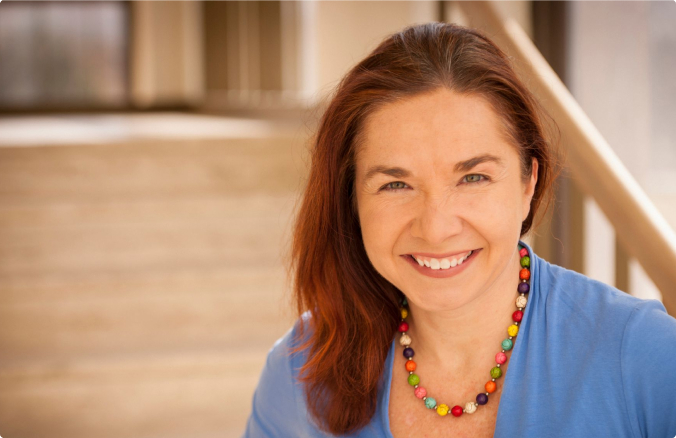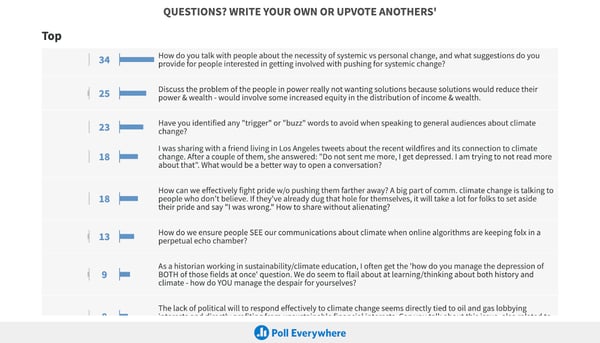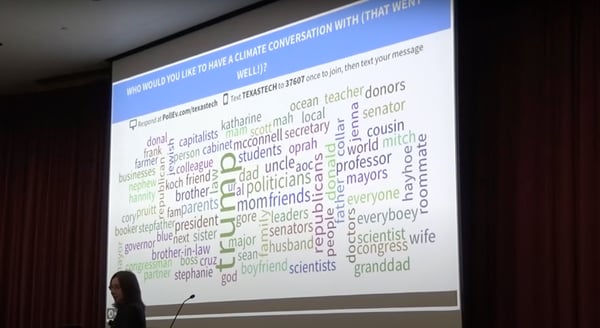Inspiring lasting discussions about climate change


- Location
- Texas
- Size
- 1000+
- Use case
- Events
"Poll Everywhere is a very important part of my toolkit for effective remote presentations. I have all the physical items I need for a good quality presentation, like a lighting system and sound panels, but in terms of personally connecting with people, Poll Everywhere is absolutely essential."
Katharine Hayhoe, Ph.D., Endowed Professor in Public Policy and Public Law at Texas Tech University and CEO of ATMOS Research, brings Poll Everywhere activities into her presentations about climate change to spark meaningful discussions with lasting impact. “So often we think of climate change as a distant issue that only matters to the polar bears or future generations, but the reality is no matter who we are, no matter where we live, it is already affecting us today in ways that matter to us. We just haven't connected the dots, and that’s why talking about it is so important.”
Discovering Poll Everywhere
It all started a number of years ago, when Katharine was invited to speak to a large group of middle school students at EarthX in Dallas, TX, the largest Earth Day festival in North America. “I thought to myself, ‘What can I do to make a talk on climate change more interesting to kids?’ so I looked around for online polling software participants could use. I knew that the university had been using clickers for a long time but all I had was my computer, a PowerPoint presentation, and their phones.”
That’s how Katharine discovered Poll Everywhere. After trying it for the first time she found that, “The students paid attention because I was asking them for their opinion, not just giving them mine, and they could see each other’s submissions come up on the screen. Of course, there were some silly answers, but most of the responses were really on point.”
Around the same time, Katharine started giving more virtual presentations because “as a climate scientist, the irony of flying around burning all this carbon to talk to people about climate change is unavoidable.” With Poll Everywhere, everyone could participate with a link and connect even when they weren’t face to face. “I would get very positive feedback from participants, like ‘I felt like you were in the same room with us!’ It was great to be able to see what everybody else was thinking virtually.”
For Katharine, the Q&A activity has shown to be a great addition to her talks.
"As soon as Poll Everywhere introduced upvoting with the Q&A activity, I started using it immediately because it was so effective. After a presentation - whether live or online - I was able to prioritize and answer the questions that the most people wanted answers to, which makes sense if you’re limited on time."

Uncovering meaningful results
Not only could she manage live questions more easily, but Katharine also walked away with lasting insights after her Q&A sessions. “Because I store those questions, I was able to look back at the submissions from several dozen talks I’d given over the last two years. I noticed that the number one and number two questions, no matter what group I spoke to, were ‘How do I have a conversation about climate change with (fill in the blank with a person’s name, from a family member to the president)?’ and ‘What gives you hope?’ So I turned that around and started to ask people what gives them hope. Then, I collected their responses in word clouds and analyzed the results. That turned into a whole talk about hope all by itself.”
A year and a half ago, Katharine was invited to give a TED talk about her outreach work. “I knew I wanted to discuss how to have a conversation about climate change because that's the number one question I get asked. Now I’m writing a book about that topic too. Collecting the data with Poll Everywhere helped me understand what people were thinking and what they most wanted to know.” As a result, her TED talk, “The most important thing you can do to fight climate change: Talk about it,” now has over 3 million views.
Katharine is very intentional about how she plans her interactive presentations. She typically creates her PowerPoint slides first and then embeds Poll Everywhere activities at critical moments.
"As I go through the presentation, I try to imagine what people will be thinking as they follow along, what I want to emphasize to them by asking them something, where I want to stop and check their responses, and where I want to lead them deeper through self-reflection."
Leading group discussions
It’s all about building a relationship and working through the ideas as a group, she says. “Once we start thinking about climate change together and realize how serious it is and how it affects us in the places where we live, what are the questions we have, what do we feel like gives us hope for the future, and what are we most worried or excited about?”
To build up to these discussions, Katharine guides participants through a variety of different activities that flow well with the content. “I usually start off with some very easy questions to help people feel comfortable with the software and comfortable with me. I'm not asking them anything high-stakes. If I'm giving a webinar where attendees are from a large geographic area, I often use a map in a clickable image activity so they can tell me where they are. If I don't know my audience, I sometimes ask a couple of multiple choice questions to learn more about them. Depending on the answers I get, I can actually change the pitch of my presentation a little bit.”

By asking these introductory questions, Katharine has noticed some interesting patterns in terms of attitude toward climate change. “I often find that when I'm speaking in a politically conservative area or setting, the organizers warn me that the majority of attendees will be conflicted about climate change or don't think it's real. But Poll Everywhere has shown me that is not in fact the case. Instead, by asking questions at the beginning, I typically find out that almost everybody in the audience actually does think it's real but is there to figure out how to talk about it with everyone else they know. In that case, I focus on equipping the small choir to reach the very big congregation. That information is essential to know at the beginning of my talk.”
Next, Katharine builds up to relevant questions with unexpected answers. She might ask, ‘How long have we known that digging up and burning coal, gas, and oil is wrapping an extra blanket around the planet that's causing it to heat up?’ The answer is actually since the 1850s, but most people don't know that. “I use Poll Everywhere in the first half of my presentation to get people thinking, to identify something they don’t know, make them curious about it, and then give them a surprising answer afterwards that they will enjoy. As neuroscientist Tali Sharot says, ‘Our brains are wired to get a kick out of information [and] treat information as if it is a reward in and of itself.’ That’s why Google is so popular!”
At the halfway mark, or even toward the last third of her presentations, Katharine has found it insightful to transition to more open-ended questions with Poll Everywhere. At that point, the audience is comfortable, thinking along the same lines, and willing to share their opinions. “I start to ask them the more thoughtful questions like, ‘What are you most concerned about?’ or ‘Who would you like to have a conversation with?’ or ‘What gives you hope?’ Getting to the questions at the end is incredibly useful as it takes our discussion to a whole different level.”
Seeing honest, thoughtful responses from everyone in the audience is easier with anonymity. “That's why I started using it in person, too. In universities, where I give a lot of my talks, there’s usually a very traditional setup with microphones. Based on who walked up to the microphone, the questions were sometimes irrelevant to most people in the audience and I noticed they were also disproportionately discouraging younger people, women, and people who didn’t feel as comfortable asking questions. With Poll Everywhere, more people's voices are actually being heard.”
"My original purpose for using Poll Everywhere was simply to keep kids paying attention, but it's evolved far beyond. Today, I use it to understand who I’m speaking to, to make people feel connected and comfortable, to emphasize points in people's minds by surprising them with the answers to their questions, and to really help them self-reflect and share what they're thinking. Once you start using Poll Everywhere and experimenting with it, you’ll find it has a lot more uses then you might have originally intended. That was definitely my experience."
Poll Everywhere for events
Energize your next virtual presentation and spark conversations with everyone in the audience.